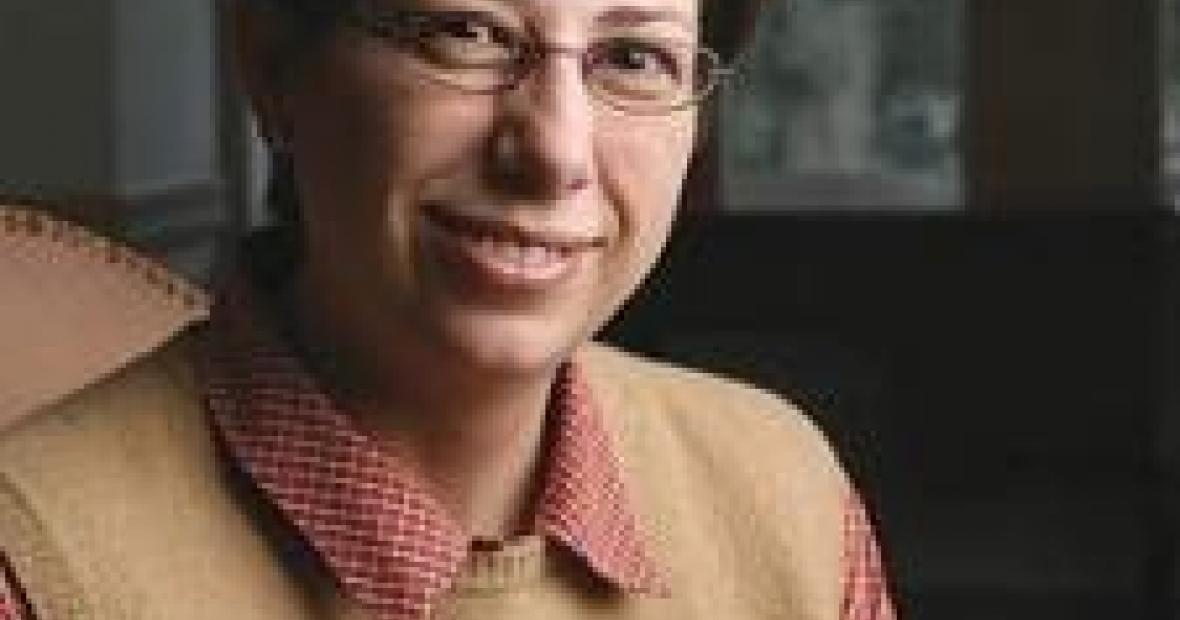The Evolution of Language
Tenure: Music to Their Ears
Carmen Valentin, newly tenured in Grinnell's Spanish department, also has scholarly and personal interests on two continents -- in her case, Europe and North America. A native of Spain, she received B.A. and Ph.D. degrees in Hispanic philology at the University of Valladolid, and cut her teeth as an instructor by teaching the university's courses in Spanish for foreign students.
That she received her doctorate in philology -- the study of the origins of language -- would suggest Valentin came into her area of study through a passion for the nuts and bolts of Spanish. She agrees readily. However, the path she has taken into a deeper understanding of Spanish has led through poetry.
More specifically, she has studied poetry and commentary in Aljamia, a system of writing the Sephardic Jews of the Iberian Peninsula began using during the Middle Ages to write Spanish using the Hebrew alphabet. The Sephardim kept this tradition alive in the new settlements they established in the Ottoman Empire after they were expelled from Spain by an edict of King Ferdinand and Queen Isabella in 1492.
"The Ottoman Empire was tolerant of other people who worshiped differently, and their communities were permitted to keep their traditions and culture intact," Valentin says. "This included the use of Aljamia."
This formerly Spanish community of Jews continued to use their Middle-Ages Spanish, which then began to evolve linguistically along different lines from the language of Spain -- hence Valentin's interest as a philologist.
"The literary texts the Judeo-Spanish created are the best tool scholars have today to study the evolution of the language," she says. "After their expulsion from the Iberian Peninsula, the Sephardim wrote a literature exclusively in Hebrew, reserving Aljamia for mere translations of the Bible, prayer books, treatises on morality, and collections of precepts. We know of only a few Aljamia texts from the 16th century that have no biblical content. The language is barely different from the Spanish spoken at that time in Spain. The 18th century really marks the time when the Sephardim start writing original works in Judeo-Spanish."
Valentin first began to look at a group of poems called coplas and a body of rabbinical commentary called the Me'am Lo'ez. These texts provided a window through which she could look at how Spanish changed under the extreme pressures of exile and encirclement by the dominant Ottoman culture. For her dissertation, Valentin transliterated -- that is, systematically converted Hebrew characters into corresponding Latin characters -- those coplas that had moral content.
"The coplas are the first original poetic expression in Judeo-Spanish, (and) the Me'am Lo'ez is the first narrative," Valentin says. "Both were born to help the rabbis teach the Judaic religious foundations to Jews who could not understand sacred readings written in Hebrew, such as Midrash and Talmud."
It was a wide open area when she began. Almost no other scholar of Spanish had been interested in either the Judeo-Spanish exiles or the body of literature they had produced. Part of the problem lay with the peculiarities of Aljamia itself: the texts, since they were written using Hebrew letters, were mostly ignored by scholars who, though they might have been experts on the Spanish language, mostly could not read Hebrew.
"This has been one of the unknown parts of Hispanic literature," Valentin says. She was fortunate in her mentors. She was introduced to Jacob Hassan, one of the foremost Spanish scholars in the world, who took her under his wing and taught her transliteration.
Though Valentin's field of study has gotten more crowded of late, that's fine with her. She's moved on from the coplas and into uncharted territory again, studying gender and language in Sephardic drama, examining women's representation in these works.
She finds Grinnell the perfect place to do such exacting work: safe, quiet, relaxed -- something she and her husband, Santi, who is an architect, value for themselves and their son Sergio, who's nearly 5 -- and with diligent students who're likely to be interested in more than acing that day's quiz on declension.
"At Grinnell I've learned that what the students were expecting of me as a professor was that I not only be the person who taught them the material, but also that I be a person who could talk to them outside of class," she says. "Really, that was not my experience in Spain. Many of the students here are willing to be challenged. They're motivated, willing to accept risks, and they attach more importance to what they are learning than just getting a good grade.

